Lucerne pioneers the modern railway station
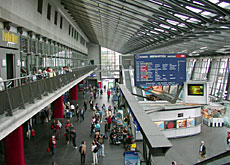
Most people arriving or departing from Lucerne railway station probably don’t give much thought to the building or its history.
But in a fourth report on Swiss stations, swissinfo finds that Lucerne’s terminus disappeared for precisely 20 years before returning to serve as a blueprint for others.
At first sight, Lucerne station can easily be dismissed as just another place where people come and go.
The terminus hardly draws a second glance from most tourists, many of whom regard Lucerne as the epitome of Switzerland.
It is no easy task competing for attention with Lucerne’s stunning views over the cruciform lake with the backdrop of Rigi and Pilatus mountains.
And with other attractions luring the crowds away, including the lake steamers, the Chapel Bridge, the new Convention Centre and the Swiss Transport Museum, the railway station struggles to catch the eye.
Look closer
But if you have the time to look a little closer, Lucerne railway station has plenty of features that arouse more than just a passing curiosity.
Perhaps the most striking feature is the light that is let into the building by the elegant curved roof and façade of glass, which are architecturally unique.
This is perhaps no surprise since the station hall was designed by Santiago Calatrava, the man responsible for the roof of the Olympic stadium in Athens.
Although the roof and glass give the entrance hall an impression of space, this is misleading because space is at a premium.
You only have to look around on the ground floor for somewhere to buy a ticket to know that Lucerne is not quite like any other Swiss railway station. There is no ticket office there.
All the usual railway facilities, including ticket and left luggage counters, are situated underground, but they are bathed in daylight from the glass roof. There are also a number of shops and restaurants.
On the first floor are more restaurants, both first and second class, as well as a conference centre. All offer views over the station’s 15 platforms.
Days of glory
Closer inspection also reveals a colourful past, and the original station buildings have a cautionary tale to tell.
“The first railway station was built in the 1850s and it was where goods and people changed from the railway to the lake,” explained Kilian Elsasser, curator of exhibitions at the Swiss Transport Museum.
“From Lucerne they could go by boat on to Flüelen at the other end of the lake and then connect to the Gotthard rail line,” he told swissinfo.
The second railway station, which opened in 1896, was a grandiose building that served as a symbol of the city for 75 years until a major fire in 1971.
It featured a glass cupola and a lantern that were not particularly typical of Swiss railway stations of the time.
“The station was made this way for a reason,” said Elsasser. “On the other side of the lake were the big hotels like the Schweizerhof, and the city authorities wanted to put up a building that was just as strong as them in terms of architecture.”
City landmark
But on the morning of February 5, 1971 the city landmark went up in flames, after fire broke out in staff quarters on the third floor.
“The old railway station was old and full of wood, and it burnt very, very quickly. Only an hour after the fire department was called, the big cupola had fallen down and was destroyed,” recalled Elsasser.
“The main clock stopped running at 9.03am and the cupola caved in at 9.06am. It was a kind of signal of the moment when the railway station stopped living,” he added.
The history books say the clocked stopped precisely at the time drawn on a design sketch of the station in 1894.
Renaissance
At 9.03am on February 5, 1991, exactly 20 years after the fire, the authorities of Lucerne inaugurated the present station. One reason it took so long to plan and build was because of a huge debate at the time over the role of public transport.
“It was around the time of the oil crisis and the renaissance of public transport. That made it difficult to think about what kind of railway station Lucerne would need,” explained Elsasser.
“The railway station of Lucerne is one of the first of this renaissance,” he added.
The building is aptly described as the first modern railway station in Switzerland, and a model of what others have become.
“The planners thought it should be a focal point of the city, not just a place to buy tickets and get on or off a train, but also to eat and shop.
“It was meant as a meeting point for the city. When you go there on a Sunday or in the evening, you can see that it has become this focal point,” said Elsasser.
In his book “Switzerland by Rail”, British author Anthony Lambert perhaps hits the nail on the head.
“Though lacking the character of the old station, the new one is a model of convenience,” he wrote.
swissinfo, Robert Brookes in Lucerne
The present rail station was opened in 1991 after the previous building was spectacularly destroyed by fire exactly 20 years earlier.
The main portal of the old station, which survived the fire, now stands as an impressive arch in the middle of the square in front of the station.
On top of the arch is a statue called “Zeitgeist” (spirit of the times) which was made by Swiss sculptor Richard Kissling.
A huge mural from the old station, “Nord et Sud” by Geneva artist Maurice Barraud, is now enclosed by glass on the west façade of the new building.
Lucerne railway station was where flautist James Galway had five of his prize flutes worth SFr300,000 ($234,380) stolen in July 1989.

In compliance with the JTI standards
More: SWI swissinfo.ch certified by the Journalism Trust Initiative
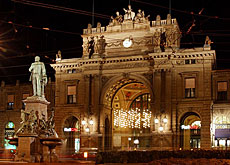
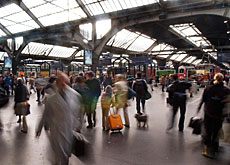
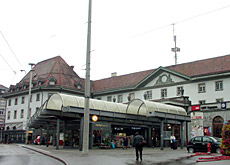
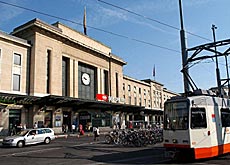
You can find an overview of ongoing debates with our journalists here. Please join us!
If you want to start a conversation about a topic raised in this article or want to report factual errors, email us at english@swissinfo.ch.